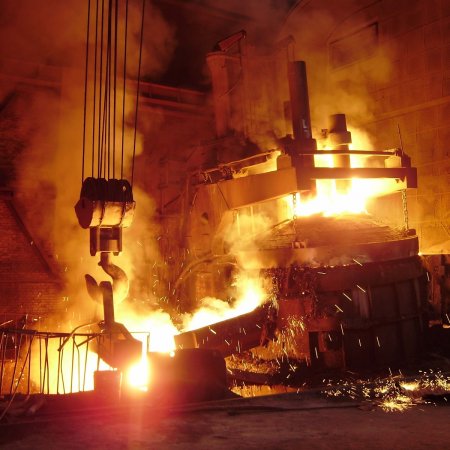


Iran is likely to become a major direct reduced iron supplier to international markets because of low energy costs and abundant iron ore reserves, a board member of Iranian Steel Producers Association said.
Increased scrap availability and usage as feedstock by mills worldwide will require a “clean” metallic as a complement, Bahador Ehramian has been quoted as saying by Kallanish—a London-based independent business media company.
"This will be particularly so in flat steelmaking electric arc furnaces," he said, adding that the potential development of blast furnace-grade DRI could also be a “game changer” for the industry.
Iran overtook India to become the largest producer of direct reduced iron in March, making India and Saudi Arabia the second and third largest DRI producing nations respectively.
The estimated DRI output by Iran during March this year was 1.29 million tons, up from 1.20 million tons a month earlier.
Iran has 3.3 billion tons of definite and a further 2.5 billion tons of prospective iron ore reserves, of which 75% are magnetite and 25% hematite. Average Fe content is 51% versus a global average of 42%.
Lower Chinese iron ore demand, coupled with new beneficiation capacity in Iran, is re-orientating Iranian iron ore trade toward the domestic market.
Iron ore production cost in Iran is lower than that of the "big four" global producers, but mine-to-port transport and freight costs are currently higher.
The government is likely to attract more investors into iron ore mining and explore new deposits for exploitation.
“The fractured ownership of the industry in addition to world class low production costs will guarantee competitive mineral input for downstream domestic users in the future,” Ehramian said.
Iran’s steel exports doubled on-year in the Iranian year through March 19, 2016, to 4.1 million tons, as producers aimed to ease excess supply at home. This occurred as apparent consumption in Iran fell a cumulative 6 million tons over three years.
Government infrastructure spending, which plummeted to $2 billion last year from $30 billion in 2012, is expected to recover this Iranian year.
"It seems the existing capacities are well positioned to meet any local shortages but not all are geared toward competition in export markets,” Ehramian said.
Iranian apparent rebar consumption increased 11% on-year in the year through March 19 to 6.23 million tons. However, flat product use declined -2% to 9.5 million tons and sections use fell -39% to 1.01 million tons. Higher rebar consumption “could be a result of overstocking, considering that almost 25% of cement kilns have been idled,” Ehramian said.
Iran is likely to become a major direct reduced iron supplier to international markets because of low energy costs and abundant iron ore reserves, a board member of Iranian Steel Producers Association said.
Increased scrap availability and usage as feedstock by mills worldwide will require a “clean” metallic as a complement, Bahador Ehramian has been quoted as saying by Kallanish—a London-based independent business media company.
"This will be particularly so in flat steelmaking electric arc furnaces," he said, adding that the potential development of blast furnace-grade DRI could also be a “game changer” for the industry.
Iran overtook India to become the largest producer of direct reduced iron in March, making India and Saudi Arabia the second and third largest DRI producing nations respectively.
The estimated DRI output by Iran during March this year was 1.29 million tons, up from 1.20 million tons a month earlier.
Iran has 3.3 billion tons of definite and a further 2.5 billion tons of prospective iron ore reserves, of which 75% are magnetite and 25% hematite. Average Fe content is 51% versus a global average of 42%.
Lower Chinese iron ore demand, coupled with new beneficiation capacity in Iran, is re-orientating Iranian iron ore trade toward the domestic market.
Iron ore production cost in Iran is lower than that of the "big four" global producers, but mine-to-port transport and freight costs are currently higher.
The government is likely to attract more investors into iron ore mining and explore new deposits for exploitation.
“The fractured ownership of the industry in addition to world class low production costs will guarantee competitive mineral input for downstream domestic users in the future,” Ehramian said.
Iran’s steel exports doubled on-year in the Iranian year through March 19, 2016, to 4.1 million tons, as producers aimed to ease excess supply at home. This occurred as apparent consumption in Iran fell a cumulative 6 million tons over three years.
Government infrastructure spending, which plummeted to $2 billion last year from $30 billion in 2012, is expected to recover this Iranian year.
"It seems the existing capacities are well positioned to meet any local shortages but not all are geared toward competition in export markets,” Ehramian said.
Iranian apparent rebar consumption increased 11% on-year in the year through March 19 to 6.23 million tons. However, flat product use declined -2% to 9.5 million tons and sections use fell -39% to 1.01 million tons. Higher rebar consumption “could be a result of overstocking, considering that almost 25% of cement kilns have been idled,” Ehramian said.
The most important tags in this website :